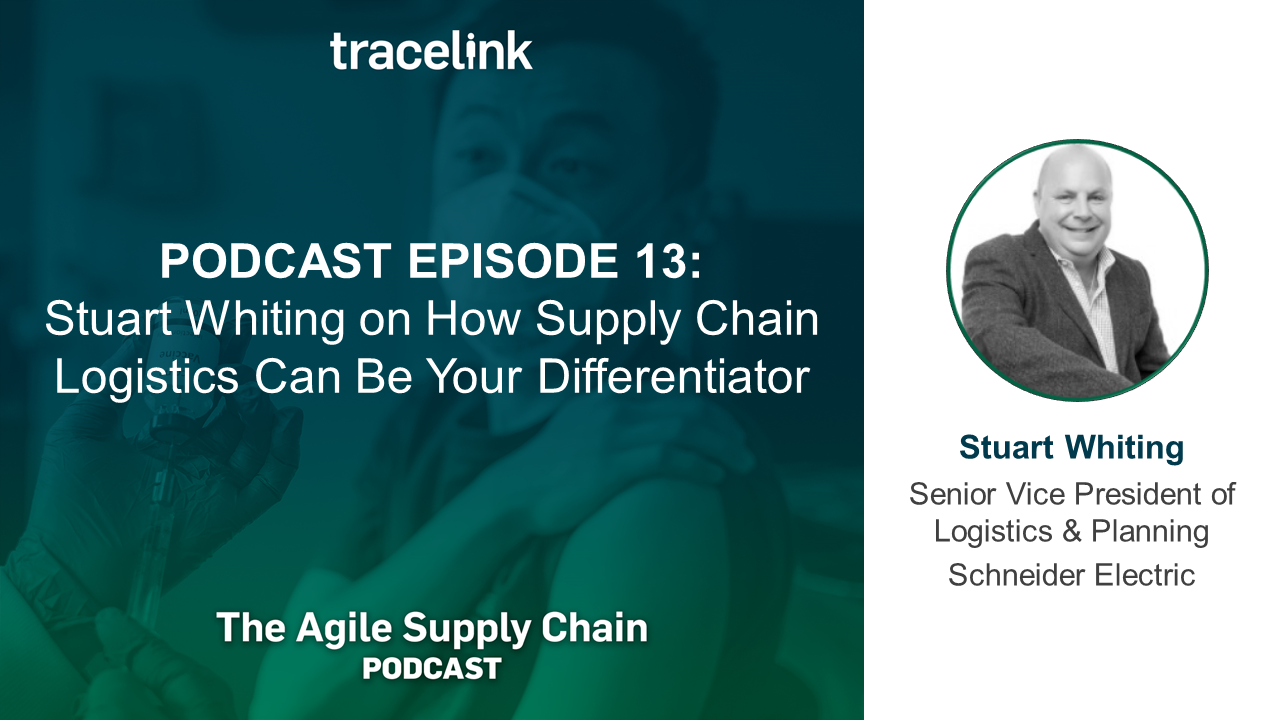Table of contents
Key Takeaways
-
Products aren’t necessarily the differentiator in a competitive marketplace, but the manner in which you deliver that product can be.
-
Customer-driven logistics hinge on understanding the specific needs and behaviors of the customer, and a one-size-fits-all approach is no longer viable.
-
Data is the bloodstream of your supply chain, and the health of that data is fundamental to achieving agility, resilience, and reliability.

Stuart Whiting, Senior Vice President of Logistics and Planning at Schneider Electric, discusses how logistics can be a key differentiator in your agile supply chain in this episode of The Agile Supply Chain Podcast.
Transcript:
Stuart Whiting, Senior Vice President of Logistics and Planning at Schneider Electric, discusses how logistics could be a key differentiator in your agile supply chain in this episode of The Agile Supply Chain Podcast with Roddy Martin.
Roddy Martin: Stuart, welcome to participating in the TraceLink thought leadership network. It's an absolute privilege to have you here. Firstly, because of our long history together. Secondly, because logistics in the end‑to‑end supply chain has always been the cornerstone.
I almost think in the end‑to‑end, demand‑driven value network, it's like the poor cousin a little bit. I'm sure that you're going to tell us a few stories about how the pandemic and the play out of events on the pandemic has actually impacted supply chain.
It's a pleasure to have you. I look forward to the discussion, and I'm going to ask you to introduce yourself and go into a little of your past roles with DHL, especially how you've seen logistics, given that you're responsible for Logistics strategy at Schneider. How has that changed? What's different?
Stuart Whiting: First of all, Roddy, thank you very much for the invite and pleasure to be with you again. As you say, we've got many years under the bridge together in many events. I'll just give a very brief introduction to myself. Stuart Whiting, I'm a Senior Vice President for Logistics and Planning at Schneider Electric. My journey really began back in 2013.
If I reflect on my background, my heritage, and who I am in the marketplace. I like to think of myself as a commercial operator with a very strong track record of what I'll call customer-centric transformation. How do we re‑engineer our business operations to really the exact needs of the customers that are in the marketplace?
In Schneider, that journey began. We're taking on logistics and network design. What is network design? Network is really, how do we configure our downstream and upstream footprint, resources, and assets to optimize our position in the marketplace and the customer delivery experience.
I took on field services, which is the after-sales support of our install basis, as we digitized data and analytics became a key component of how we move to the next level of efficiency. Built the data and analytics teams out in India and in the Philippines, which is now extending out into the regions as we speak and more recently brought on planning.
Prior to that, I was a lifer at DHL, if you wish. My roles have been operational and commercial, significant roles in building the strategic and global account management processes and teams, as well as the solution design elements of that group. General management in Japan and Taiwan, including country presidents.
My last role was the Global Head of Multinational Customers, Government and Defense working in the headquarters in Bonn, Germany. Really, what I see about the role of logistics, and what I've seen that evolve over time? For me, I think logistics really now is the differentiator.
What I mean by differentiation is that products don't necessarily differentiate to too much in the marketplace when you've got competition, but it's the manner in which you deliver that. How do our salespeople differ the products and service offering compared to the competition, and importantly, the delivery experience that our customers experience?
Traditionally, in the old silo mentality in the organizations, logistics would have been referred to, and as you'd say, the poor cousin of the supply chain looked upon as box movers. They didn't quite understand how value could be injected, how differentiation could be placed to really ensuring the perfect order, and more importantly, a plausible experience from the eyes of the customers.
For me, I'm seeing a transition from box moving to one that is now really focused upon reliability, agility, transparency, and visibility across the supply chain combined with our usual metrics around the cost to serve.
Truly understanding end‑to‑end processes from the eyes of the customer, but more importantly now, the role that data automation and analytics can bring, and that logistics really are by nature true collaborators.
Logistics really understand the need for upstream and downstream to coordinate well together, be transparent and open in terms of sharing information and data in order to be able to affect that perfect delivery experience, if you wish. That is a bit of my background and a little bit of my perception of how I've seen logistics evolve over time.
Roddy: I'm going to pick up on a point that you made because I think it's fascinating in a little bit of context. As I talk to supply chain leaders in pharmaceutical, I'm not being derogatory by saying that they are absolute laggards in the supply chain.
They've relied on 300 days' worth of inventory and high margins to support the business model. That's how they guaranteed supply. Just throw away 15 percent of product you made. You make sure you've got hundreds of days floating around. It's just not like that anymore.
I was fascinated when you said design the supply chain network from the customer back. I'm a little staggered when I hear chief supply chain officers in the pharmaceutical space say, "Well, yes, it's patient‑centric, but we haven't got our way around to thinking about the patient yet." I think that's just a stage in a journey.
I'm sure you've seen that before, where logistics was pushed, was supply‑driven, and you never thought about the customer except just to meet the service level requirements. Designing the network from the customer back to supply must be a very fundamental part of your strategy.
Stuart: Indeed. That involves going out and talking to your customers but being very structured in terms of what you're trying to understand from that customer basis there. From my perspective, the stack-it-high, sell-it-cheap lean methodology that's traditionally associated with logistics is going out and understanding the attributes that drive the buying behavior are in.
Each [patient or consumer] has different demands or attributes that's driving their behavior. Clearly, a one‑size‑fits‑all push approach to meeting demand is no longer right. You've got to understand the intricacies and also the switching points between which costs will outride service and which service outrides cost. You can only do that by getting to know your customers.
Surprisingly, my colleagues in sales and marketing, and I often refer to them as “smileys,” and having been a smiley myself, don't always understand the motivations, or don't understand what's driving the articulation of need from the customers that are there.
Going out and recognizing these different behaviors has taught us a lot about how we need to re‑engineer the supply chain. That it's not just about being one‑size‑fits‑all, that you actually do need variability in response.
Similarly, we need to drive modularization or value stream mapping and lean processes to deliver it efficiently, regardless of the difference in the buying behavior that we're recognizing.
We're finding logisticians now far more commercially‑aware and customer‑aware, and understanding the tweaks and the trade‑offs that need to be made to meet that exact need of a customer whilst maintaining profitability and competitiveness as well in the actual physical transaction itself.
For me, it's far more about just understanding how a warehouse works, the optimization of transportation modes, containers, and equipment. It is about what value points do you need to trigger within the supply chain to meeting those needs?
Critically, how do you sense and predict the needs and the changes in that marketplace as well? You'll have a core buying behavior that you can identify with. You can then reengineer backwards through your supply chain how you'll fulfill that demand chain. How do you also then sense and predict any variation that may come in that demand?
Again, customers go through various different demands at any one time. A customer could be lean, for example, very cost or automated in their relationship with you. They're going to have moments where they will need agility and response as well. How do you have a bimodal approach to managing these relationships, while equally driving efficiency and fulfillment?
Roddy: I'm so glad that you have articulated that demand‑driven segmentation. John Gattorna is actually one of the recorded webinar guests that we've got coming up in the next couple of weeks. I think it's had a profound impact. I believe that Schneider used the outside‑in, demand‑driven segmentation models from John Gattorna as the basics of your logistics strategy.
I think it's profound because how did we do that before? We contracted logistics capacity and pushed them with product out into the marketplace, and we relied on efficiency to meet service levels. We’ve got to be smarter than that, especially in life sciences and especially in healthcare where in the future you may be dealing with a patient community of ten. Ten people with cancer and a very specific personalized drug, or even one patient.
Gone are the days where you just pump the marketplace full of product. You've got to be very targeted in delivering what could be a cold chain product right into a patient's hand inside of a hospital within a very specific time domain window, so that they can be implemented.
It's great to hear you articulate that demand‑driven segmentation because I think there is, and I'm not teaching you anything, especially you, a new view of segmentation from the patient back.
Watch that catch on in the pharmaceutical industry because reliability and demand for cost accuracy is sometimes in the 50 percent, sometimes in the 50, 60 percent range. You can't run a business like that. You can't save patients like that unless you have hundreds of days' worth of inventory.
Stuart, talk a little about...because I know that without harping on Schneider specifically, but a lot of companies are going through this, well, we spent a lot of money on our ERP systems and we've consolidated and harmonized all our instances, but we still don't have end‑to‑end visibility.
We still don't have that transparency of the end‑to‑end supply network and obviously in healthcare, it's all built around the patient. It's only a reason healthcare exists. Talk a little bit about how you've moved from an ERP paradigm to something else. Let's call it digital, for want of a better word.
Stuart: First of all, each organization is unique, however, customer buying behaviors are agnostic. What I mean by that is you're not particular to any one industry. They will vary. You could be an OEM in India who behaves very differently to an OEM in California, Florida, or in China.
For me, understanding how that customer responds. How they need to be served and reengineering through the supply chain requires one critical point.
That is really understanding your own end‑to‑end processes because again, before you digitize, before you leverage any of your ERP architecture or decide on any tools that you may need to help you in that process, you really need to understand what data is critical to deliver or to assure that perfect order regardless of what the demand is there.
Whilst mapping the perfect end‑to‑end supply chain and applying the principles of value stream mapping, here, we've also written what we call our data supply chain.
What are the domain‑specific data objects that we require to drive excellence and source, plan, make, or deliver perspective once we've got visibility to the order and the demand or the forecasting?
Then, what data objects within each of those demands needs to come together within a unification layer so that we can then begin to orchestrate that end‑to‑end supply chain response to demand and then equally, in bringing that all together, how do we represent that up or downstream so that it drives the right actions out of that domain level or in the management of the complete order management cycle that the customer's placing upon you.
In here, it's understanding the processes, but drilling down a lot further and really understanding and driving excellence in data. I always say, to me, data is like blood in the human body. The better your blood is, the better the blood work is in terms of all the tests, guess what, the healthier you are as a human being.
To me, the healthier your data is, the excellence of the data and integrity of the data that you're providing within the supply chain, guess what, the efficiency of the supply chain is far greater. Not just in managing the day‑to‑day operations and fulfilling that perfect order but being able to drive things like analytics and automation where we take inefficiencies out of the supply chain.
You create the visibility, the sensing and the predict capabilities, it means you can be far more educated now in what's coming and what will be potentially there in the future. You can sense where shortages will be happening. You can be able to sense changes and demand patterns and then consequently flex the supply chain or begin to build that agility and flexibility in terms of how you respond.
Not just of the now and the event management. I've looked at what happened in 2008 and 2009 as an event. I've looked at Fukushima and the very unfortunate events around the tsunami in Japan as an event, but when you start to think about something like COVID, this isn't an event. This is something that's going to go on for two-to-four years.
Evermore, the resilience, visibility, and as I've shared with you earlier on, the role of logistics and driving collaboration across the supply chain, so you can be agile and responsive to need and demand, is ever greater.
You can only do that with the right visibility to data, the orchestration of that data and how you unify it. How you present the data to the key decision makers, stakeholders within the supply chain that are then going to orchestrate the activity within it, and then more importantly, how do you reliably manage the expectations of the customer?
It's about making sure you're transparent in what can be done. I remember one thing from my days, in particularly working with the DOD, MOD and NATO forces, is you can only go to war with what you've got, not what you wish you had.
You've got to be completely transparent in managing that customer expectation about delivery dates, product availability and what can and cannot be done, but equally offer solutions or alternates and hopefully not come to a straight no decision.
Again, data visibility, transparency, and then critically at the end of all of this, is ensuring you've got the right competencies within the organizations to manage that as well.
Roddy: What you said about the ministry, MOD and the military, that's exactly analogous to healthcare. You've got a weapon that needs a round of ammunition to do a job. Likewise, you've got a patient who's waiting for a particular medicine, and until you deliver that medicine, the job's not done.
There's a lot of analogies. If there's one thing that really has come out of me, and it maybe should've if I'd sat and thought about it enough, but you've really emphasized it, and that is how logistics has to operate as an agile network amongst all the partners.
If anybody's got to pick up the slack, it's got to be the logistics partners because I can move my manufacturing to another country. I can move my manufacturing to another site. I can move it to a contract manufacturer, but I still expect my logistics providers to pick up the stuff and get it to the ultimate destination at the point in time when it was supposed to be there.
There's probably a lot of logistics network partnership strategies and best practices that could be shared with the healthcare industry as we go forward. I'm hoping that happens because logistics and supply chain has been seen as just moving boxes rather than the patient‑driven supply network that get contracted for very specific roles, for example, cold chain.
That's a fascinating point and it's really good to emphasize. Stuart, as we close off, I would love it if you could give us three core thoughts, and I think you've shared some of them with us already, just that you'd like to emphasize as a logistics leader that's really done your time in other industries.
Maybe you've had some experience in healthcare at DHL, but in the last years, it's been more with the industrial sector in Schneider. What would you share that you think is real three nuggets for any supply chain leader to keep in their back pocket around the ongoing role and strategic nature of logistics as a capability?
Stuart: Really understand the end‑to‑end picture. There's still way too much silo behavior when I look at industries outside of my own. Indeed, it was the biggest challenge we had within the transformation we've managed at Schneider.
Equally, when I was working with the 3PL at DHL, the lack of communication within an organization and collaboration as a customer, and consequently, the difficulties we then had in executing, was hard.
The skills that really are required are data, digital without a doubt, but good collaborative, non‑egotistical traditional [indecipherable 21:11] behaviors that we had in the past. This really is a true sharing ecosystem of the future. You're looking at competencies where people see the power of sharing.
Sharing of information, sharing of best demonstrated practices. Those are the people that win. Those that think, I get all the information and keep it to myself and I'll operate a pull model, "when you ask for it, I'll share it," those days are gone. For me, very clear end‑to‑end processes. A complete embracing of the digital capabilities that are out there today.
Interestingly enough, it's about having faith and trust in strategic partners as well. Again, this is another area where you've got internal collaboration, but external collaboration. I still feel today that organizations don't partner properly with their strategic partners. They don't properly leverage what they can bring to the table in terms of technology or data. What can you bring into your solution set?
As I think of our end‑to‑end capabilities, and the data architecture we manage, and the systems and tools, it is actually an outside‑in approach, which is truly leveraging third party capabilities. Then there's, how do we move that data within that echo system, that hybrid platform, which gives us a differentiating edge of the future?
For me, end‑to‑end processes, the competencies in the future in terms of the people that you require and a very strong foundation around data and digitization. With that, you can then build the agility and resilience that you require to fulfill the demand. Maybe a bit long‑winded, but I hope there are some key nuggets in there.
Roddy: No. There absolutely are. Again, I'm going to make the point that I think there are a lot of best practices in industries like consumer goods and consumer electronics and industrial that need to be translated into this very parochial healthcare industry, which is more silo than anything because you have the FDA requiring systems of record, and heaven forbid you should share the wrong data with the wrong partner and get yourself into trouble.
That trust element has a whole new component to it. I don't just share all my data with my contract manufacturers or with my logistics providers because heaven forbid, I should share data with them and in the process incriminate myself in a compliance issue.
There are dimensions of supply chain that make healthcare complicated. Just demand forecast accuracy. Patient data is private, so now you have the problem, how on earth do you get insights on demand forecast accuracy when you're not allowed to touch patient data.
Stuart, I want to thank you really a lot for the time that you've invested with us. It's an absolute pleasure to have you.
Stuart: Thank you, Roddy.
Return to: The Patient-Driven Supply Network






